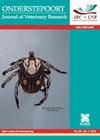猪体内连续传代对H1N1禽流感病毒适应性的影响
IF 1.6
3区 农林科学
Q2 VETERINARY SCIENCES
引用次数: 0
摘要
病毒聚合酶缺乏校对活性和甲型流感病毒(IAV)基因组的片段性是导致IAV遗传多样性及其适应新宿主能力的原因。我们试图通过在猪体内的连续传代使禽流感病毒(avIAV)适应猪,并评估了点突变的发生及其对猪体内病毒适应性的影响。材料与方法用50头仔猪接种A/duck/Bavaria/77菌株共25次体内传代,预定传代数后,20头未接种仔猪通过与接种动物接触接触病毒。每日评估猪流感的临床症状。用鼻拭子和肺组织进行实时RT-PCR检测IAV RNA,并对所选传代分离物进行测序。结果感染猪除直肠温度升高和散发咳嗽外,未见典型临床症状。原菌株需要20代传代才能明显提高其复制能力。共鉴定出29个氨基酸取代。其中18个在第一个测序株中检测到,16个在所有其他分析株中也检测到。更多的传代检测到额外的突变。神经氨酸酶(NA)中的苏氨酸(T) 135取代丝氨酸(S),仅在接触暴露仔猪的IAV分离物中检测到。结论传代25次获得了部分适应猪的IAV。分离物复制能力的提高很可能与碱性蛋白(PB) 1中的S654取代甘氨酸(G)、PB2中的天冬氨酸(D) 701取代天冬氨酸(N)和精氨酸(R) 477取代G、血凝素中的谷氨酸(E) 204取代D和G239E以及NA中的T135S有关。本文章由计算机程序翻译,如有差异,请以英文原文为准。
Effect of Serial in Vivo Passages on The Adaptation of H1N1 Avian Influenza Virus To Pigs
Abstract Introduction The lack of proofreading activity of the viral polymerase and the segmented nature of the influenza A virus (IAV) genome are responsible for the genetic diversity of IAVs and for their ability to adapt to a new host. We tried to adapt avian IAV (avIAV) to the pig by serial passages in vivo and assessed the occurrence of point mutations and their influence on viral fitness in the pig’s body. Material and Methods A total of 25 in vivo avIAV passages of the A/duck/Bavaria/77 strain were performed by inoculation of 50 piglets, and after predetermined numbers of passages 20 uninoculated piglets were exposed to the virus through contact with inoculated animals. Clinical signs of swine influenza were assessed daily. Nasal swabs and lung tissue were used to detect IAV RNA by real-time RT-PCR and isolates from selected passages were sequenced. Results Apart from a rise in rectal temperature and a sporadic cough, no typical clinical signs were observed in infected pigs. The original strain required 20 passages to improve its replication ability noticeably. A total of 29 amino-acid substitutions were identified. Eighteen of them were detected in the first sequenced isolate, of which 16 were also in all other analysed strains. Additional mutations were detected with more passages. One substitution, threonine (T) 135 to serine (S) in neuraminidase (NA), was only detected in an IAV isolate from a contact-exposed piglet. Conclusion Passaging 25 times allowed us to obtain a partially swine-adapted IAV. The improvement in isolate replication ability was most likely related to S654 to glycine (G) substitution in the basic protein (PB) 1 as well as to aspartic acid (D) 701 to asparagine (N) and arginine (R) 477 to G in PB2, glutamic acid (E) 204 to D and G239E in haemagglutinin and T135S in NA.
求助全文
通过发布文献求助,成功后即可免费获取论文全文。
去求助
来源期刊
CiteScore
4.30
自引率
0.00%
发文量
13
审稿时长
16 weeks
期刊介绍:
The Onderstepoort Journal of Veterinary Research, is the official publication of the Onderstepoort Veterinary Institute. While it considers submissions from any geographic region, its focus is on Africa and the infectious and parasitic diseases and disease vectors that affect livestock and wildlife on the continent.

 求助内容:
求助内容: 应助结果提醒方式:
应助结果提醒方式:


